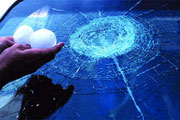 |
 |
 |
|
Coverage Concerns Automobile comprehensive coverage Addressing an ongoing need By Roy C. McCormick It is important for drivers to continue their comprehensive coverage (aka loss other than caused by collision) during the time their vehicle carries a relatively high value. Many people terminate their collision coverage when an automobile loan is paid off; others who have no loan drop the coverage when the book value of the covered auto drops to the point that self insurance is economically sound for them. Recent weather-related occurrences as well as significant man-made problems call attention to the scope and importance of automobile comprehensive coverage. Following is a review of exposures that are covered and their relevance to recent or current problems: • Water damage. Widespread heavy rain has increased the cost of repairs to interior furnishings and to engine and electrical equipment. • Windstorm. Powerful winds and tornadoes across many states, especially in the Midwest and the south, have badly damaged or destroyed automobiles. Automobile comprehensive coverage covers wind damage to the property that is usually the second biggest investment people make. • Earthquake. The potential for earthquake is not limited to California. The New Madrid (Missouri) fault is considered by the U.S. Geological Survey to be a major threat for earthquake activity in the eastern part of the United States. On November 9, 1968, the strongest earthquake (5.4 magnitude) recorded in the Midwest and south in recent years was centered in south-central Illinois and was felt in 23 states. As recently as June 19, 2002, a moderate quake (5.0) with an epicenter near Evansville, Indiana, was felt throughout Indiana and in Illinois, Kentucky, Missouri, Ohio and West Virginia. On April 21, 2002, a magnitude 5.1 quake collapsed parts of roads in New York state and cracked chimneys and foundations in the northeast from Maine to Maryland. Insurance agents should emphasize the importance of including the earthquake peril under automobile comprehensive coverage because damage to vehicles can be severe. • Fire. In terms of weather-related exposures, automobiles are as subject to wildfires (brushfires) as dwellings and buildings. Fire loss to autos is included in comprehensive coverage and is an exposure when dwelling and building fires occur, whatever their cause. • Vandalism or malicious mischief. The two terms combine to cover intentional damage. Damage brought about by pure meanness—scratching a car with a sharp object, denting a car with a hard object or breaking a car window—is one example. Another is when labor problems bring about actions that cause intentional damage to trucks and other vehicles. Much of that type of damage is covered. (Police reports are important in supporting claims.) • Theft or larceny. The potential for theft of a vehicle can be minimized by always locking it when it is not going to be occupied—even briefly. However, such loss does occur. It is comforting to know that comprehensive coverage will apply in most cases. Under comprehensive coverage, most insurers will pay transportation expenses for 30 days (basically $20 daily) if a covered vehicle is stolen. Reimbursement for temporary rental of a car can be significant if there is delay in recovery of a stolen vehicle. A higher limit of rental reimbursement coverage than the usual basic limit is available for additional premium. • Riot or civil commotion. There have been several occasions in recent years when considerable property damage occured during riots or civil commotions. Most of the loss involved commercial property, but personal as well as commercial vehicles can also incur damage. Comprehensive coverage pays the damages in most cases. • Contact with animals. Many people would consider damage to a vehicle caused by an animal attempting to run across a highway a subject for collision coverage. However, it is automobile comprehensive coverage that applies. Loss can be considerable. Front-end body work involving the hood, radiator, glass and interior parts can be costly. • Missiles or falling objects. Such events don’t occur very often, but the consequences can be serious. A portion of a roof or the side of a building can drop off onto parked vehicles. Similar damage can be caused by a large chunk of ice. An old tree or telephone pole also can be an offender. Agents have a significant service opportunity in discussing comprehensive auto protection and its reasonable cost. * The author |
|
|||||||||||||
| ||||||||||||||
